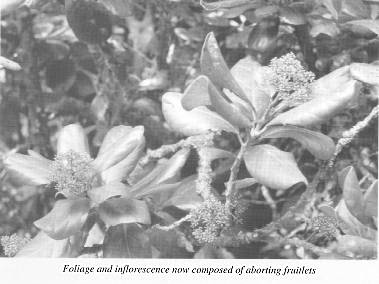
| Pennantia
baylisiana Reproduced from an article by Professor G. T. S. Baylis From The New Zealand Garden Journal (Journal of the Royal New Zealand Institute of Horticulture), Vol. 2, No. 1, March 1997, pp. 12-13.  T.
F. Cheeseman was an early Director of the Auckland Museum. He was
also the first botanical explorer of the Three Kings Islands. On his
visits in 1887 and 1889 he had only a few hours ashore, yet he found
six new plants. A more thorough search was clearly warranted but it
was not until 1945 that the Museum arranged for a scientific party
to camp on the main island. I was the botanist.
By this time wild
goats had eaten the place out. Part was closely browsed grass but
most was kanuka forest or scrub. Cheeseman's novelties survived in
small numbers beyond browse range. It was easy to see that the grassland
offered nothing new, but the kanuka canopy was broken here and there
by other textures and shades of green. I located these places by climbing
trees at every vantage point and reached them deviously via bluffs
and screes since except in the main valley they were, even for goats,
a bit inaccessible. T.
F. Cheeseman was an early Director of the Auckland Museum. He was
also the first botanical explorer of the Three Kings Islands. On his
visits in 1887 and 1889 he had only a few hours ashore, yet he found
six new plants. A more thorough search was clearly warranted but it
was not until 1945 that the Museum arranged for a scientific party
to camp on the main island. I was the botanist.
By this time wild
goats had eaten the place out. Part was closely browsed grass but
most was kanuka forest or scrub. Cheeseman's novelties survived in
small numbers beyond browse range. It was easy to see that the grassland
offered nothing new, but the kanuka canopy was broken here and there
by other textures and shades of green. I located these places by climbing
trees at every vantage point and reached them deviously via bluffs
and screes since except in the main valley they were, even for goats,
a bit inaccessible.In these clumps such
things as puriri, mahoe and mangeao persisted and I soon found the
liane Tecomanthe speciosa and the rangiora with a corky
trunk like a cabbage tree - Brachyglottis arborescens.
The last little grove that I investigated lay near the highest point
of the island down a scree of boulders about 200m above the sea.
I was drawn to it by what looked like a karaka. I was soon gazing
upon it in disbelief since a third find seemed too much to expect.
But this was no karaka - its leaves were larger and recurved strongly
in the sun, its bunches of small green flowers sprang from the bare
branches below the leaves and there were no big berries - indeed
none at all. Dr W. R. B. Oliver, our
last true biologist equally authoritative about animals or plants
was anxious to identify my finds and I sent them to him. Lacking
time and experience, I feared I might blunder by getting a family
wrong. This danger proved real indeed, for Oliver himself put the
pseudo-karaka in the Anacardiaceae, which is close to the karaka
family, whereas had I been able to send fruits he would have realized
that the resemblance to karaka is misleading, the proper family
being Icacinaceae to which Pennantia belongs. It was a European botanist working with herbarium sheets who realised that the Three Kings specimens were Pennantia: indeed concluded that the tree was just a stray P. endlicheri from Norfolk Island. But herbarium sheets don't tell all - thicker leaves recurving curiously in the sun, stouter stems and flowers on leafless branches rather than at the ends of twigs so distinguish the Three Kings tree, that the two have little resemblance. So when our Flora is next revised either the definition of Pennantia will be broadened to accommodate cauliflory (flowers arising on old wood) or Oliver's genus Plectomirtha will reappear as a member of the Icacinaceae. The former seems the wiser course as P. baylisiana does occasionally flower at a branch tip. Moreover, the objective of taxonomy is to synthesise and there is no synthesis when a species has a genus to itself.
Propagating this lone
and sterile tree, not in the best of health because of insect damage,
seemed urgent. There was a detachable shoot at its base which took
root in a damp sheltered place in my Dunedin garden and is now very
like its parent with four slender trunks. But its canopy trimmed
by occasional frost rather than repeated salty gales is taller (7m). While I was unsure that this shoot had really rooted, I was worried by failure both at the Plant Diseases Division at Mt Albert and at Duncan and Davies, New Plymouth to strike cuttings from the crown. I asked George Smith the chief propagator at New Plymouth what I might do to provide better cuttings. "Cut the tree down" he said, and while I shuddered at the thought he explained that he was confident about rooting shoots from the stump. But would there be any? Well, the tree had four trunks so I dared to sever one. A year later the shoots were there, the Naval launch on which I was a guest gave them a quick passage to New Plymouth which happened to be its next port and Mr Smith soon placed the survival of "Plectomirtha" beyond doubt.
|
Home | Journal
| Newsletter | Conferences
Awards | Join
RNZIH | RNZIH Directory | Links
© 2000–2024 Royal New Zealand Institute of Horticulture
Last updated: March 1, 2021

